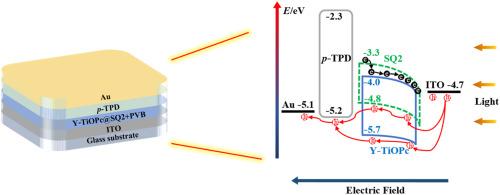吲哚方胺染料有机光电探测器提高近红外灵敏度的酞菁钛
IF 4.6
3区 工程技术
Q2 ENGINEERING, ELECTRICAL & ELECTRONIC
引用次数: 0
摘要
本研究采用体异质结(BHJ)策略,将squaraine (SQ2)掺杂到y型酞菁钛(Y-TiOPc)中,通过调整SQ2的掺杂比例来优化器件性能。结果表明,基于[email protected] %SQ2的光电探测器在365 nm至940 nm的宽光谱范围内表现出优异的光电性能。在0.01 mW cm−2的光强下,器件在850 nm处的最大光响应率(R)为109,634 mA W−1,对应的外量子效率(EQE)为16,004%。与基于y - tiopc的光电探测器相比,基于[email protected] % sq2的器件在近红外(NIR)区域的R和EQE值分别提高了7.08 (700 nm)、6.28 (765 nm)、4.92 (850 nm)和3.47 (940 nm)倍。此外,该装置表现出快速、稳定、可重复的光响应。性能的增强主要是由于Y-TiOPc和SQ2之间的共敏增效增强效应,以及BHJ结构带来的载流子生成、分离和输运的改善。本研究表明,基于TiOPc和squaraine染料的BHJ方法通过引入squaraine掺杂来增强近红外探测能力,为提高光电探测器的性能提供了一种有效的策略。本文章由计算机程序翻译,如有差异,请以英文原文为准。

Indoline squaraine dye-based organic photodetectors to boost NIR sensitivity for titanyl phthalocyanine
In this work, a bulk heterojunction (BHJ) strategy was employed by doping squaraine (SQ2) into Y-type titanyl phthalocyanine (Y-TiOPc), aiming to optimize the device performance by adjusting the doping ratio of SQ2. The results revealed that the photodetector based on [email protected] %SQ2 exhibited excellent optoelectronic performance across a broad spectral range from 365 nm to 940 nm. Under a light intensity of 0.01 mW cm−2, the device achieved a maximum photoresponsivity (R) of 109,634 mA W−1 at 850 nm, with a corresponding external quantum efficiency (EQE) of 16,004 %. Compared to the Y-TiOPc-based photodetector, the [email protected] %SQ2-based device demonstrated significantly enhanced R and EQE values in the near-infrared (NIR) region, with increases by factors of 7.08 (700 nm), 6.28 (765 nm), 4.92 (850 nm), and 3.47 (940 nm), respectively. Moreover, the device showed a rapid, stable, and reproducible photoresponse. The performance enhancements are mainly attributed to the co-sensitization synergistic enhancement effect between Y-TiOPc and SQ2, as well as the improvement in carrier generation, separation, and transportation brought by the BHJ structure. This study demonstrates that the BHJ approach based on TiOPc and squaraine dye offers an effective strategy for improving photodetector performance by introducing squaraine doping to enhance NIR detection capabilities.
求助全文
通过发布文献求助,成功后即可免费获取论文全文。
去求助
来源期刊

Materials Science in Semiconductor Processing
工程技术-材料科学:综合
CiteScore
8.00
自引率
4.90%
发文量
780
审稿时长
42 days
期刊介绍:
Materials Science in Semiconductor Processing provides a unique forum for the discussion of novel processing, applications and theoretical studies of functional materials and devices for (opto)electronics, sensors, detectors, biotechnology and green energy.
Each issue will aim to provide a snapshot of current insights, new achievements, breakthroughs and future trends in such diverse fields as microelectronics, energy conversion and storage, communications, biotechnology, (photo)catalysis, nano- and thin-film technology, hybrid and composite materials, chemical processing, vapor-phase deposition, device fabrication, and modelling, which are the backbone of advanced semiconductor processing and applications.
Coverage will include: advanced lithography for submicron devices; etching and related topics; ion implantation; damage evolution and related issues; plasma and thermal CVD; rapid thermal processing; advanced metallization and interconnect schemes; thin dielectric layers, oxidation; sol-gel processing; chemical bath and (electro)chemical deposition; compound semiconductor processing; new non-oxide materials and their applications; (macro)molecular and hybrid materials; molecular dynamics, ab-initio methods, Monte Carlo, etc.; new materials and processes for discrete and integrated circuits; magnetic materials and spintronics; heterostructures and quantum devices; engineering of the electrical and optical properties of semiconductors; crystal growth mechanisms; reliability, defect density, intrinsic impurities and defects.
 求助内容:
求助内容: 应助结果提醒方式:
应助结果提醒方式:


